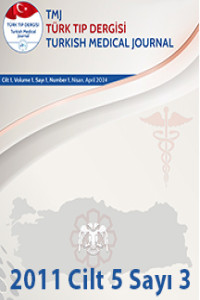Abstract
ÖZET
Altı yaşındaki hasta sağ gözünde kayma şikayetiyle kliniğimize başvurdu. Sağ gözü için siklopleji sonrası sferik ve silindirik değerler sırasıyla +6 dioptri (D) ve 1.25 D’ydi. Sol göz
sadece 0.5 D’lik silindirik refaksiyon kusuruna sahipti. Gözlük camıyla tam bir tashih sonrası sağ ve sol gözün Snellen eşelindeki görme keskinliği sırasıyla 0.05 ve 0.8 idi. 6 aylık gözlükle tam bir tashih ve kapama tedavisi sonrası sağ gözün görme keskinliği sadece 0.1’e çıktı. Bunun üzerine aileyi kullanımı hakkında bilgilendirdikten sonra silikon hidrojel kontakt lens kullanmaya karar verdik. Kontakt lens kullanımından 3 ay sonra görme keskinliği 0.3’e, 6 ay sonra ise 0.5’ya çıktı. Klasik gözlük ve kapama tedavisine iyi cevap vermeyen bu vaka, gözlük kullanımından fayda görmeyen yüksek anizometropik ambliyopili vakalarda kontakt lens kullanmanın faydalı olabileceğini göstermektedir.
ABSTRACT
A six-year old patient was admitted to our clinic with the complaint of the deviation of the right eye. The spherical and cylindrical refractive errors after cycloplegic drops were +6 dioptres
(D) and +1.25 D respectively for the right eye. The left eye had only 0.5 D of cylindrical refractive error. After full correction with eye glasses the visual acuities of the right and the
left eye were 0.05 and 0.8 respectively on the Snellen chart. After prescribing full refractive error and occlusion therapy for sixmonths the visual acuity of the right eye improved only to
0.1, therefore; we decided to give silicon hydrogel contact lenses after informing the family about their use. Three months after starting contact lenses the visual acuity improved to 0.3
and then improved to 0.6 after six months. This case illustrates the importance of contact lens usage in cases with anisometropic amblyopia who do not benefit from eye glasses and
occlusion therapy
Keywords
References
- 1. Holmes JM, Clarke MP. Amblyopia. Lancet 2006;367:1343-51.
- 2. Coşkun M, Akal A, Öner AÖ, Doğan H. Anizometropik ambliyopisi olan hastalara uygulanan kapama tedavisinin binoküler görme üzerine etkisi. Yeni Tıp Dergisi. 2008;25:232-5.
- 3. Yıldız AA, Bardak Y. Anizometropik ambliyopi olgularında kapama tedavisinin refraksiyon kusurlarına göre etkinliği.Türk Oftalmoloji Dergisi 2011;41(6):385-388.
- 4. Abrahamsson M, Sjostrand J. Natural history of infantile anisometropia. Br J Ophthalmol 1996;80:860-3.
- 5. Flynn JT, Woodruff G, Thompson JR, et al. The therapy of amblyopia: an analysis comparing the results of amblyopia therapy utilizing two pooled data sets. Trans Am Ophthalmol Soc 1999;97:373-90; discussion 90-5.
- 6. Steele AL, Bradfield YS, Kushner BJ, France TD, Struck MC, Gangnon RE. Successful treatment of anisometropic amblyopia with spectacles alone. J AAPOS 2006;10:37-43.
- 7. Paysse EA, Coats DK, Hussein MA, Hamill MB, Koch DD. Long-term outcomes of photorefractive keratectomy for anisometropic amblyopia in children. Ophthalmology 2006; 113: 169 –176.
- 8. Daoud YJ, Hutchinson A, Wallace DK, Song J, Kim T. Refractive Surgery in Children: Treatment Options, Outcomes, and Controversies. Am J Ophthalmol 2009; 147 : 573-582e2.
- 9. Roberts CJ, Adams GG. Contact lenses in the management of high anisometropic amblyopia. Eye (Lond) 2002;16:577-9.
- 10. Wilson MS, Milis EAW. History, indications and terminology of contact lenses. In: Wilson MS, Milis EAW. Contact Lenses in Ophthalmology.Butterworth&Co. (Publishers); 1988:1-6.
Abstract
References
- 1. Holmes JM, Clarke MP. Amblyopia. Lancet 2006;367:1343-51.
- 2. Coşkun M, Akal A, Öner AÖ, Doğan H. Anizometropik ambliyopisi olan hastalara uygulanan kapama tedavisinin binoküler görme üzerine etkisi. Yeni Tıp Dergisi. 2008;25:232-5.
- 3. Yıldız AA, Bardak Y. Anizometropik ambliyopi olgularında kapama tedavisinin refraksiyon kusurlarına göre etkinliği.Türk Oftalmoloji Dergisi 2011;41(6):385-388.
- 4. Abrahamsson M, Sjostrand J. Natural history of infantile anisometropia. Br J Ophthalmol 1996;80:860-3.
- 5. Flynn JT, Woodruff G, Thompson JR, et al. The therapy of amblyopia: an analysis comparing the results of amblyopia therapy utilizing two pooled data sets. Trans Am Ophthalmol Soc 1999;97:373-90; discussion 90-5.
- 6. Steele AL, Bradfield YS, Kushner BJ, France TD, Struck MC, Gangnon RE. Successful treatment of anisometropic amblyopia with spectacles alone. J AAPOS 2006;10:37-43.
- 7. Paysse EA, Coats DK, Hussein MA, Hamill MB, Koch DD. Long-term outcomes of photorefractive keratectomy for anisometropic amblyopia in children. Ophthalmology 2006; 113: 169 –176.
- 8. Daoud YJ, Hutchinson A, Wallace DK, Song J, Kim T. Refractive Surgery in Children: Treatment Options, Outcomes, and Controversies. Am J Ophthalmol 2009; 147 : 573-582e2.
- 9. Roberts CJ, Adams GG. Contact lenses in the management of high anisometropic amblyopia. Eye (Lond) 2002;16:577-9.
- 10. Wilson MS, Milis EAW. History, indications and terminology of contact lenses. In: Wilson MS, Milis EAW. Contact Lenses in Ophthalmology.Butterworth&Co. (Publishers); 1988:1-6.
Details
| Primary Language | Turkish |
|---|---|
| Subjects | Clinical Sciences (Other) |
| Journal Section | Case Reports |
| Authors | |
| Publication Date | December 26, 2011 |
| Published in Issue | Year 2011 Volume: 5 Issue: 3 |


